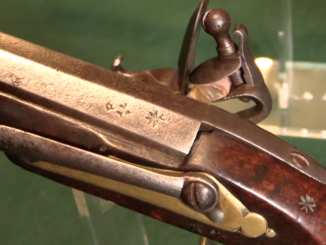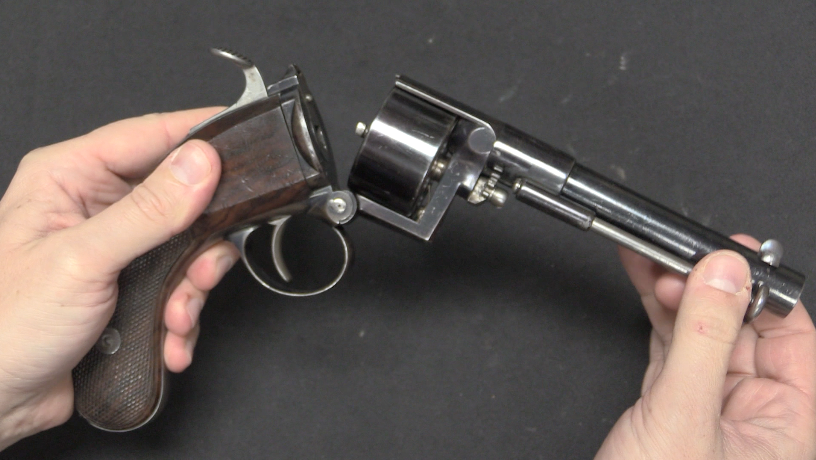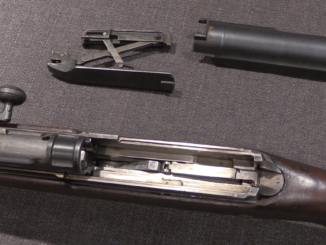“Chassepot to FAMAS: French Military Rifles 1866-2016” is in stock and shipping now:
https://www.headstamppublishing.com/purchase
The rarest pattern of factory-made Chassepot is the fusil modèle 1866 pour la cavalerie d’afrique – the Model 1866 rifle for African cavalry. Just 12,000 of these were made by St Etienne in the spring of 1869, as a way to equip the mounted French troops in Algeria with the new needlefire rifle that the rest of the Army had. After some field testing with standard Mle 1866 Chassepot rifles, it was determined that really all they needed was a change in sling position, so that riders could carry the weapon slung diagonally across the back. To do this, a number of changes were made to the rifle. The stock was strengthened, reinforced at the trigger guard, the rear sling swivel moved to the trigger guard, and a wider third barrel band added with the front sling swivel.
After the Mle 1866 cavalry carbine went into production in 1870, the need for these specialized rifles disappeared. No more were made, and as they were worn out they were rebuilt into standard configuration Mle 1866 infantry rifles. Very, very few survive today, and I’m and very excited to have this one to show you!




I just saw the video on this rare rifle; very interesting. I’m not a French gun nerd, unfortunately. But I am a Vintage/Antique gun Fan. I watch your Forgotten Weapons videos while I ride on the subway.
Hmm. Remade into INFANTRY versions? Seem like needless work adding a longer barrel and new sights. With that extra wood, would the rebuilds be detectable? Or did they restock them as well.
Unless I completely missed the point of the video, this was not a carbine, so no new bbl needed.
Wonderful to see Ian geek out on his favorite topic.
My late father-in-law fashioned a bayonet lug for a 27″ AR-15 pencil bbl to mount a Chasspot bayonet on, so that I could put together a Christmas rifle for my daughter almost as long as she is tall.
Ian may yet turn me into a French rifle nerd. My first brush with Forgotten Weapons came years ago when I was able to obtain a beautiful Berthier Mle 1892 M16 carbine. I had always wanted one. Why? I don’t know. Beauty is in the eye of the beholder, I guess.
Anyway, I got the little darling home and then realized that I had no idea how to properly field strip the thing to clean it. Voila! Forgotten Weapons and our favorite Francophile to the rescue.
Thanks Ian. Keep the content coming!
A trooper of the Chasseurs d”Afrique showing the cross-body carrying of the carbine.
https://en.wikipedia.org/wiki/Chasseurs_d%27Afrique#/media/File:Chasseur_d'Afrique,_bataille_de_la_Marne_1914.jpg
“The Chasseurs d’Afrique were a light cavalry corps of chasseurs in the French Armée d’Afrique (Army of Africa). First raised in 1831 from regular French cavalry posted to Algeria, they numbered five regiments by World War II. For most of their history they were recruited from either French volunteers or French settlers in North Africa doing their military service. As such they were the mounted equivalent of the French Zouave infantry. The other major cavalry element in the Armee d’Afrique were the Spahis—recruited from the indigenous peoples of Algeria, Tunisia, and Morocco with mostly French officers. https://en.wikipedia.org/wiki/Chasseurs_d%27Afrique
“Spahis (French pronunciation: [spa.i]) were light-cavalry regiments of the French army recruited primarily from the Arab and Berber populations of Algeria, Tunisia and Morocco” https://en.wikipedia.org/wiki/Spahi
I had briefly mentioned this on the video comments, but I have a Chassepot rifle that was converted by the Kynoch Rifle Company in Birmingham to either 11mm Gras or, I thought, 11mm Mauser as I wonder if these were made to sell to China as “faux” 1871 Mausers. The rear site is more like the 71 as for the pivot for the leaf is at the rear of the block rather than the front as on the Chassepot’s. It has the re-enforcing screw and the sling swivel on the trigger guard as on the African cavalry model and the serial number has a O prefix.
I beg’s the question as to where Kynoch got these from. It must have been very good condition when they got them, mauybe they were never delivered? I should also say that other Kynoch’s I have seen do not have the African features.
One last thing, the cheese headed screw that retains the bolt has a blind hole drilled in it, I thought this was an anomally but it is the same on all the ones I have seen, I wonder what the purpose was?